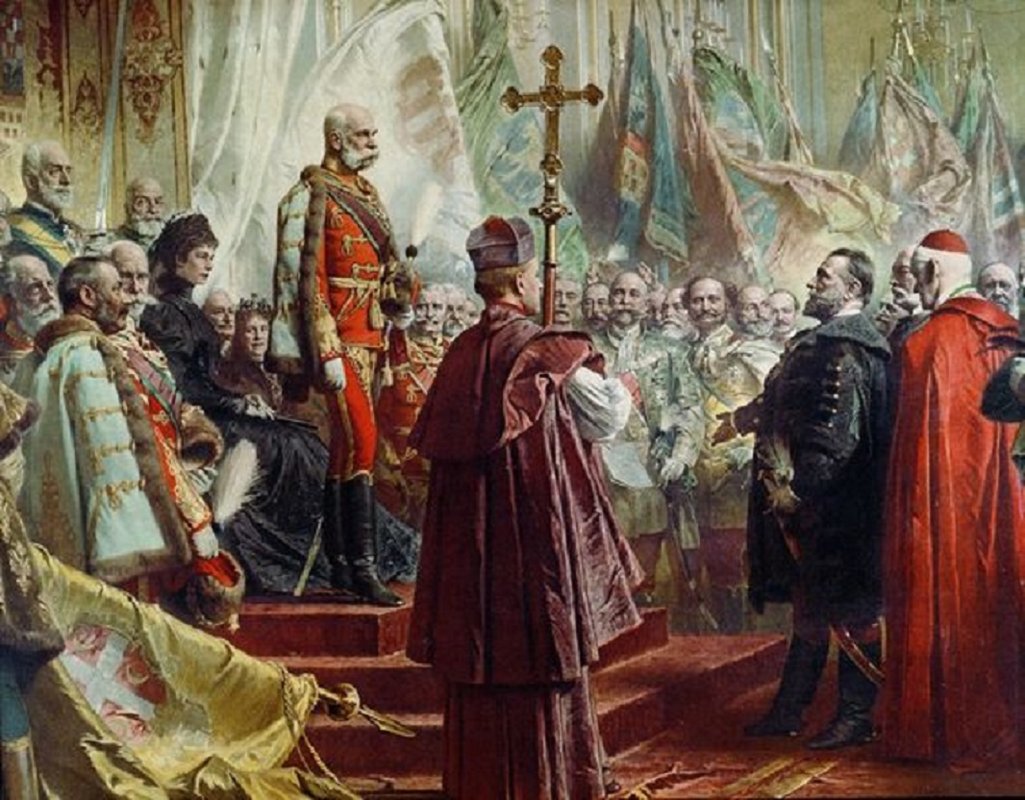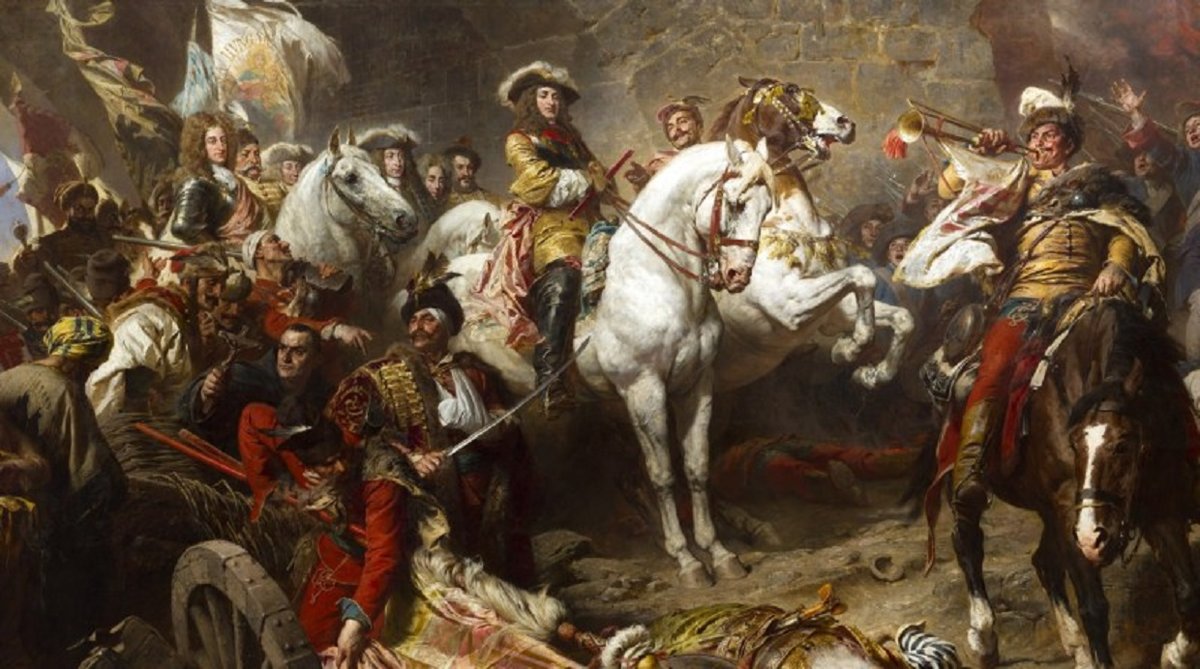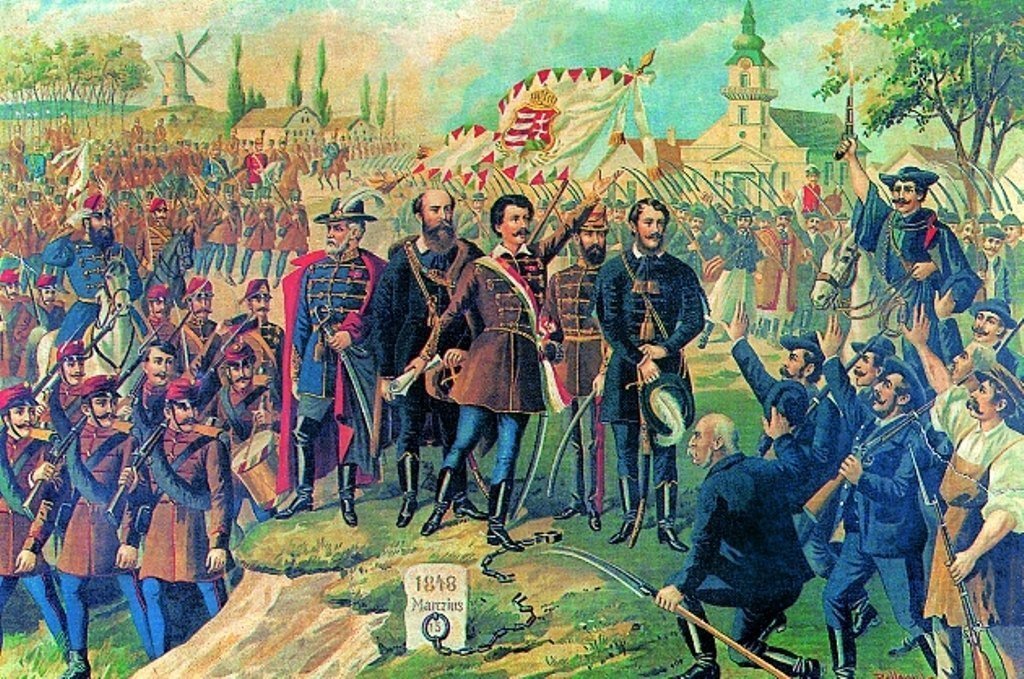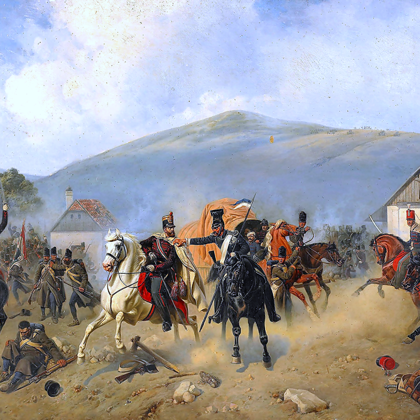THE HUNGARIAN REVOLUTION (1848-1849),HUNGARY THE FIGHTING SPREADS BACK ASTRO - CROATIAN INVASION. THE CROATIAN ARMY WAS SENT TO HUNGARY BY HABSBURG DYNASTY TO REMOVE THE REVOLUTIONARY HUNGARIAN GOVERNMENT.
 The
Emperor Francis Joseph of Austria-Hungary dressed in the robes of the
Order of the Golden Fleece.Francis
Joseph I 18 August 1830 – 21 November 1916, was Emperor of Austria,
Apostolic King of Hungary, King of Bohemia, King of Croatia, King of
Galicia and Lodomeria and Grand Duke of Cracow from 1848 until his death
in 1916. From 1 May 1850 until 24 August 1866, he was President of the
German Confederation.Middle Common Coat of Arms of Austria-Hungary.
The
Emperor Francis Joseph of Austria-Hungary dressed in the robes of the
Order of the Golden Fleece.Francis
Joseph I 18 August 1830 – 21 November 1916, was Emperor of Austria,
Apostolic King of Hungary, King of Bohemia, King of Croatia, King of
Galicia and Lodomeria and Grand Duke of Cracow from 1848 until his death
in 1916. From 1 May 1850 until 24 August 1866, he was President of the
German Confederation.Middle Common Coat of Arms of Austria-Hungary.
One of the biggest challenges of Stephan and his descendants was the stabilization of Christianity and to Europeanize the previously nomadic Hungarian people. During the Arpad and from 1301, the Anjou dynasties medieval Hungary was flourishing (except for the devastating two years of the Mongol invasion). Mathias Corvinus made Hungary a Central European renaissance cultural hub, an idol for other countries. But besides all the development and blaze, a new power was threatening Europe from the Balkan, the Ottoman Turkish Empire, against which Hungary served as a bulwark for the continent.In the 18th century Hungary was desperate to recover from Turkish devastation. Habsburgs repopulated the uninhabited areas of the country with Romanians and Slovaks, artificially creating large blocks of minorities. The advancing theories of nationalism and liberalism reached Hungary in the early 19th century and the Habsburg rule became disagreeable. The development of civil society led to the 1848-49 revolution and uprising against Habsburgs, that broke out in today’s Budapest, the 15th of March 1848.The revolution didn’t provoke positive results and Austria imposed strict and oppressing regulations towards the country. Later on they realized that they can only cooperate with Hungarians if they give them some sort of autonomy. This consolidation process led to the Austro-Hungarian compromise of 1867, creating the new leading power of central Europe, the Austro-Hungarian Empire. This pact was really favorable for Hungarians and Hungarian economy started to boost and till the early 1900s Hungarian GDP grew at a very fast pace. The country became a semi-developed agro-industrial economy, and Budapest emerged to the leading European metropolises with a brand new, unique cityscape and novelties such as the first underground on the continent.Through the 19th century much of Central and South-east Europe was ruled from Vienna, the seat of the Hapsburg Empire, known as the Austro-Hungarian Empire from 1867. Its provinces, shown in this map, were inhabited by many different nationalities. After defeat in the First World War, the empire was dissolved. Austria and Hungary separated, and parts of the empire joined Italy, Romania, the restored Poland and the new states of Czechoslovakia and Yugoslavia. In the 1990s the component states of Czechoslovakia and Yugoslavia became independent.The agreement was a compromise between the emperor and Hungary, not between Hungary and the rest of the empire. Indeed, the peoples of the empire were not consulted, despite Francis Joseph’s earlier promise not to make further constitutional changes without the advice of the imperial parliament, the Reichsrat. Hungary received full internal autonomy, together with a responsible ministry, and, in return, agreed that the empire should still be a single great state for purposes of war and foreign affairs. Francis Joseph thus surrendered his domestic prerogatives in Hungary, including his protection of the non-Magyar peoples, in exchange for the maintenance of dynastic prestige abroad. The “common monarchy” consisted of the emperor and his court, the minister for foreign affairs, and the minister of war. There was no common prime minister (other than Francis Joseph himself) and no common cabinet. The common affairs were to be considered at the delegations, composed of representatives from the two parliaments. There was to be a customs union and a sharing of accounts, which was to be revised every 10 years. This decennial revision gave the Hungarians recurring opportunity to levy blackmail on the rest of the empire.The Kingdom of Hungary had always maintained a separate parliament, the Diet of Hungary, even after the Austrian Empire was created in 1804. The administration and government of the Kingdom of Hungary (until 1848) remained largely untouched by the government structure of the overarching Austrian Empire.
 The
Turkish occupation,after the death of Mathias, royal power weakened and
eventually in 1526 the country could not resist Turkish attacks anymore
and the country fell into 3 parts – the area of Ottoman occupation,
Transylvania, and the considerably smaller
Kingdom of Hungary. For more than 150 years Turks continued their
expansion through numerous battles. Royal Hungary became part of the
Habsburg Empire, while Transylvania operated as an independent entity.
At the beginning of the 18th century finally Habsburgs were ready to
strike back with Hungarians to reunite the country and push Turks back
to the Balkan. In 1718 finally Hungary became reunited within the
Habsburg Empire.
The
Turkish occupation,after the death of Mathias, royal power weakened and
eventually in 1526 the country could not resist Turkish attacks anymore
and the country fell into 3 parts – the area of Ottoman occupation,
Transylvania, and the considerably smaller
Kingdom of Hungary. For more than 150 years Turks continued their
expansion through numerous battles. Royal Hungary became part of the
Habsburg Empire, while Transylvania operated as an independent entity.
At the beginning of the 18th century finally Habsburgs were ready to
strike back with Hungarians to reunite the country and push Turks back
to the Balkan. In 1718 finally Hungary became reunited within the
Habsburg Empire.
The Ottoman–Hungarian Wars were a series of battles between the Ottoman Empire and the medieval Kingdom of Hungary. Following the Byzantine Civil War, the Ottoman capture of Gallipoli, and the decisive Battle of Kosovo, the Ottoman Empire was poised to conquer the entirety of the Balkans and also sought and expressed desire to expand further north into Central Europe beginning with the Hungarian lands.Initial Hungarian success culminated in the Crusade of Varna, though without significant outside support the Hungarians were defeated. Nonetheless the Ottomans suffered more defeats at Belgrade, even after the conquest of Constantinople. In particular, the notorious Vlad the Impaler, with limited Hungarian help, resisted Ottoman rule until the Ottomans placed his brother, a man less feared and less hated by the populace, on the throne of Wallachia. Ottoman success was once again halted at Moldavia due to Hungarian intervention, but the Turks finally succeeded when Moldavia and then Belgrade fell to Bayezid II and Suleiman the Magnificent, respectively. In 1526 the Ottomans crushed the Hungarian army at Mohács with King Louis II of Hungary perishing along with 14,000-20,000 of his foot soldiers. Following this defeat, the eastern region of the Kingdom of Hungary (mainly Transylvania) became an Ottoman tributary state, constantly engaged in civil war with Royal Hungary. The war continued with the Habsburgs now asserting primacy in the conflict with Suleiman and his successors. The northern and most of the central parts of Hungary managed to remain free from Ottoman rule, but the Kingdom of Hungary, the most powerful state east of Vienna under Matthias II, was now divided and constantly threatened by Ottoman ambitions in the region.Hungary's central government structures remained well separated from the imperial government. The country was governed by the Council of Lieutenancy of Hungary (the Gubernium) - located in Pozsony and later in Pest - and by the Hungarian Royal Court Chancellery in Vienna, the capital of the ethnically diverse Austrian Empire, was a leading cultural center in Europe. Full of artists, composers, writers, and intellectuals, Vienna was truly the jewel of the Austrian Empire, and the Austrian empire, led by Metternich, was the paragon of reactionary politics. Yet the various ethnic groups in Austria had become increasingly nationalist over the preceding decades, and by now they all yearned to express their individual volksgeist and gain independence. Medieval Hungary,one of the biggest challenges of Stephan and his descendants was the stabilization of Christianity and to Europeanize the previously nomadic Hungarian people. During the Arpad and from 1301, the Anjou dynasties medieval Hungary was flourishing (except for the devastating two years of the Mongol invasion). Mathias Corvinus made Hungary a Central European renaissance cultural hub, an idol for other countries. But besides all the development and blaze, a new power was threatening Europe from the Balkan, the Ottoman Turkish Empire, against which Hungary served as a bulwark for the continent. Hungarians were a minority in the Hungarian Republic they had just declared, which included large numbers of Romanians, Serbs, Croats, and others. The Austrian leadership retired their feeble-minded emperor and put his strong-willed and reactionary brother Franz-Joseph on the throne. He refused to accept Hungarian independence, an once he had put down the workers' revolt in Vienna he began the work of reconquering Hungary. He called in help from the Russian Tsar, who sent in 20,000 troops in the name of solidarity among reactionary emperors. More importantly, he worked on all of Hungary's other minorities, convincing them that this Hungarian state was no good for them. The Hungarian government helped by repeatedly declaring their state by and for Hungarians; Lajos Kossuth, one of the leaders, later said that their mistake was in declaring one Hungarian state, rather than a chain of ethnic republicans for Romanians, Serbs, Bohemians, and others.The revolution didn’t provoke positive results and Austria imposed strict and oppressing regulations towards the country. Later on they realized that they can only cooperate with Hungarians if they give them some sort of autonomy. This consolidation process led to the Austro-Hungarian compromise of 1867, creating the new leading power of central Europe, the Austro-Hungarian Empire. This pact was really favorable for Hungarians and Hungarian economy started to boost and till the early 1900s Hungarian GDP grew at a very fast pace. The country became a semi-developed agro-industrial economy, and Budapest emerged to the leading European metropolises with a brand new, unique cityscape and novelties such as the first underground on the continent.
On
29th of September 1848, the Hungarian army led by Lieutenant-General
János Móga defeated the troops of the Croatian Ban Josip Jelačić in the
battle of Pákozd located in Central Transdanubia. The Croatian army was
sent to Hungary by the Habsburg dynasty to remove the revolutionary
Hungarian government, which came into power by Vienna’s approval as the
result of the successful and peaceful revolution of 15 March 1848.
In 1848 revolution, the Opposition Circle drafted the ‘demands of the Hungarian nation,’ the famous Twelve Points constituting the essence of Kossuth’s program and reflecting the ideas of the Pest radicals. The twenty-five-year-old poet Sándor Petőfi, drafted the fiery ‘National Song,’ and the next day the young revolutionaries had the poem and the Twelve Points printed without the censor’s approval.The battle was part of the Hungarian Revolution of 1848-1849. At the end of the Napoleonic Wars, the great powers of Europe had agreed among themselves to preserve the traditional order of the continent. Most people would continue to be ruled by kings and emperors, the British would preserve their ancient mixed, largely aristocratic government, and the democratic and nationalist energies released by the French Revolution would be suppressed. This led to a century of political struggle. Parties from the mildly reformist to the anarchist sought to reduce the power of kings and increase that of the people, and also to achieve independence for their own peoples from the multi-national empires (British, Russian, Austro-Hungarian) that ruled them.In March 1848, a radical Hungarian Magyar group led by Louis Kossuth began a vocal independence movement. Kossuth's fiery speeches were soon printed in Vienna, where they started a sensation and soon an uprising. Metternich, monitoring the Revolutions throughout Europe, had become fearful. He decided to flee, and quickly snuck out of Vienna. The situation probably wasn't as bad as he thought, but once news got out that Metternich had left, the Austrian revolutionaries got truly excited.Queen Zita of Hungary and Crown Prince Otto of Hungary (Otto von Habsburg) arrive at the royal palace in Budapest on coronation day 1916 december 30(th)Charles I (Karl Franz Joseph Ludwig Hubert Georg Otto Maria, 17 August 1887 – 1 April 1922) was the last reigning monarch of the Austro-Hungarian Empire. He was the last Emperor of Austria, the last King of Hungary (as Charles IV),the last King of Bohemia (as Charles III), and the last monarch belonging to the House of Habsburg-Lorraine. After his uncle Franz Ferdinand was assassinated in 1914, Charles became the designated successor of the Emperor Franz Josef. Charles I reigned from 1916 until 1918, when he "renounced participation" in state affairs, but did not abdicate. He spent the remaining years of his life attempting to restore the monarchy until his death in 1922. Beatified by Pope John Paul II in 2004, he is known to the Catholic Church as Blessed Karl of Austria.Austrian Czechs and numerous Austrian controlled Italian states followed the Magyars lead. Some of the revolutionary excitement also spilled into Prussia, where, to ease the pressure, the Prussian King Frederick William IV promised a constitution. On March 15, Kossuth's Hungary was granted independence under Hapsburg rule. The Czech movement in Bohemia soon received the same status, and Italian states like Milan soon overthrew Austrian occupation.In June 1848, the revolutions in Austria began to run out of steam. After all, it was a non-industrialized country that did not have a well-developed middle class. Their revolution, largely led by intellectuals and students, could not marshal the same amount of popular support as the bourgeoisie in Western Europe.In June 1848, in Prague, a group of Slavic nationalists held a Pan-Slavism conference in an attempt to stop Bohemia from being swallowed by Germany. The conference soon became violent. Emperor Ferdinand of Austria smashed the Prague insurrection using the army, and he also sent his forces against the rebellious Italian states of Lombardy and Milan, which were soon reconquered. In September and October of 1848, Louis Kossuth started a movement to make Magyar the official language of Hungary, even though only half of the population of Hungary spoke Magyar. The Serbo-Croatians, who did not speak the Magyar language, rebelled and asked the Hapsburgs for help. In December, another rebellion in Vienna led Emperor Ferdinand to abdicate, putting his son, Franz Joseph, into power. Franz Joseph quickly appealed to the Russians, who marched into Hungary and crushed the Magyars. The 1848 revolutions in Austria came to an end, restoring order in the Empire.From then on Hungarians had to suffer under a communist dictatorship. The economy collapsed during the 1950s and the standard of living was falling dramatically. Social dissatisfaction led to an uprising and an announced withdrawal from the Warsaw Pact in October 1956. This attempt met a massive military intervention by Moscow. Later on, under the leadership of Janos Kadar a slow consolidation started. In 1968, Hungary began liberalizing its economy, introducing the so-called “Goulash Communism.” The standard of living started to rise, travel restrictions became less strict and Hungary became an idol and a prosperous nation within the Eastern bloc.
 Sandor
Petofi 1823-49 and his famous proclamation of Talpra Magyar on the 15
March 1848. The Hungarian Revolution of 1848 and 1849, closely linked to
the events of the Spring of Nations, which to this day remains the most
widespread revolutionary wave in European history.He is considered
Hungary's national poet, and was one of the key figures of the Hungarian
Revolution of 1848. He is the author of the Nemzeti dal (National
Song), which is said to have inspired the revolution in the Kingdom of
Hungary that grew into a war for independence from the Austrian Empire.
It is most likely that he died in the Battle of Segesvár, one of the
last battles of the war.
Sandor
Petofi 1823-49 and his famous proclamation of Talpra Magyar on the 15
March 1848. The Hungarian Revolution of 1848 and 1849, closely linked to
the events of the Spring of Nations, which to this day remains the most
widespread revolutionary wave in European history.He is considered
Hungary's national poet, and was one of the key figures of the Hungarian
Revolution of 1848. He is the author of the Nemzeti dal (National
Song), which is said to have inspired the revolution in the Kingdom of
Hungary that grew into a war for independence from the Austrian Empire.
It is most likely that he died in the Battle of Segesvár, one of the
last battles of the war.

